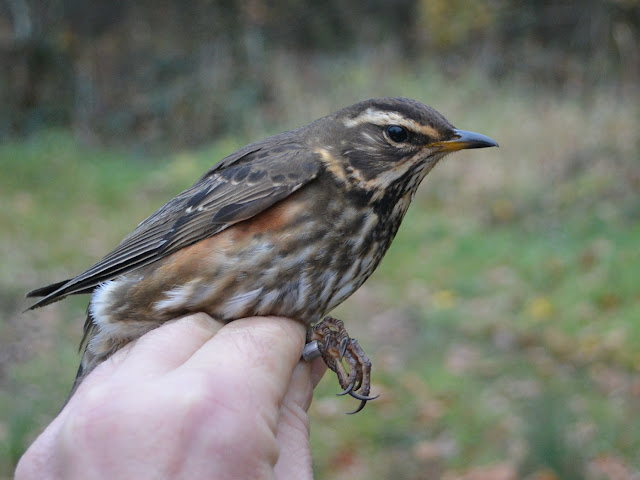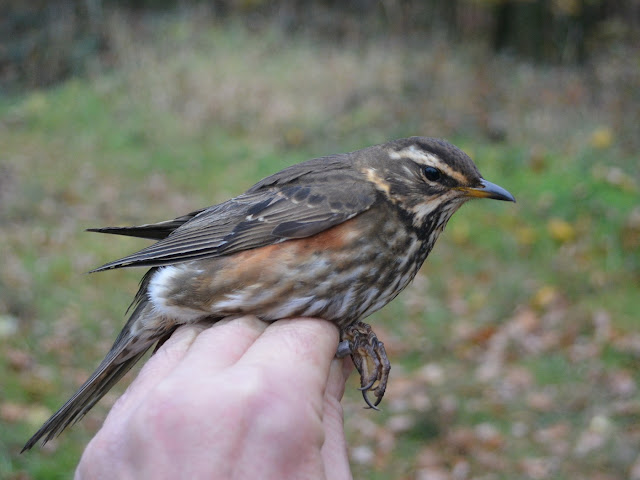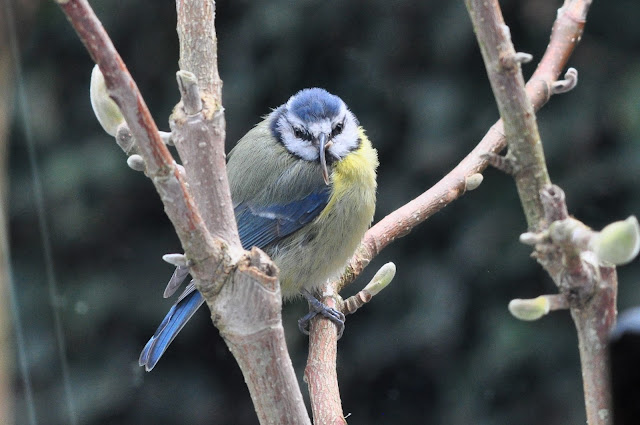When I received a recovery report for a Redwing I had identified as being of the Icelandic race and it had actually been recovered in Iceland I was more than a little pleased and surprised, to say the least. I have ringed 3675 Redwings on Billinge Hill and at Crawford since 2014 but only a very tiny proportion of those have been of the Icelandic race 'coburni'. Add in the relatively low recovery rate for Redwings of roughly 1 in 500 from my ringing and 1 for every 1166 from all ringing in Britain and Ireland up to 2020 (BTO online ringing report) and there was very little chance of having one of my Icelandic Redwings recovered anywhere, let alone in Iceland. In terms of likelihood getting this recovery report was a bit like winning the lottery.
Redwing (Turdus iliacus coburni)
RY31104 first year 17/11/2018 Billinge Hill, Billinge, Merseyside, UK
Caught by ringer 25/03/2022 Akureyri, Norður, Eyjafjarðarsýsla, Iceland
Duration: 1224 days Distance: 1600 km Direction: 328deg (NNW)
When I looked at the recoveries in BTO online ringing report there had only been 32 Redwings recovered in Iceland from all ringing in Britain and Ireland up to 2020. Of those 32 recoveries 29 had been ringed in Scotland, 1 in Ireland, 1 in Wales and again only 1 in England. An analysis of Redwing recoveries by R.D.P Milwright using data from birds ringed in the breeding season indicated that Icelandic Redwings winter almost entirely in Scotland, Ireland, western France and northwest Iberia. Also that adults and birds from eastern Iceland are more likely to be recovered in Scotland and Ireland while those from Western Iceland are more likely to be found in France and Iberia.
I have had a long standing interest in Icelandic Redwings which started in the early days of my ringing when I was with Leigh Ringing Group and we used to catch large numbers of Redwings at a roost site near Bolton. In those days I used to wonder how difficult or easy it would be to identify 'coburni' given they were generally described as averaging a bit darker and longer winged. Not only that but did they even occur in north-west England given what was known and published at that time. Back in those days, like many ringers, I used to think the best initial clue would be size with any long winged bird (126mm+) being a candidate for the Icelandic race but that ignores the fact that there is a huge overlap in the range of wing lengths the 2 races display. If my memory serves me correct we didn't catch any particularly long-winged Redwings at that roost site, certainly none that would be outside the normal range of the nominate race 'iliacus' and nor did any appear to be noticeably darker.
My interest in this subject was revived when I started ringing on Billinge Hill in 2014 and found I was able to catch large numbers of Redwings from migrating flocks in autumn with the help of a new sound lure. On 16th November 2014 I caught a Redwing that was noticeably darker but I was cautious and only tentatively suggested it could be an Icelandic bird and wrote about it in a blog post here. On 20th November 2014 I caught another dark and heavily marked Redwing and this time I was convinced it must be an Icelandic Redwing. It had a wing length was 127mm, so was quite big but not necessarily outside 'iliacus' range, depending on which reference you use. It also made me realize that I had been too cautious with the individual I had caught a few days earlier and that too was an Icelandic bird. This second bird resulted in me writing a blog post Redwings: coburni v iliacus (link here) which has become one the most popular posts on this blog, such is the interest in separating the two races.
While I had become happy that I could pick out well marked Icelandic birds regardless of their wing length I was still left wondering how similar in appearance to 'iliacus' some of them might be and I still don't know the answer to that one. Since those first two Icelandic Redwings I have caught a few others in most autumns (usually in late October or November) but I have also caught others that I considered fell short in terms of appearance to varying degrees. My ringing notebooks are littered with notes on the appearance of Redwings and it is why I can't put an exact number on how many Icelandic birds I have actually ringed because I may have been too cautious in some cases. Some were put down as definite 'coburni' and that number only gets into low double figures but others were put down as possibles or probables for one reason or another. I have also caught a quite a few long winged birds that appeared to be typical 'iliacus' in terms of appearance but had wing lengths of 127mm and 128mm. However, the two longest wing lengths I have recorded were 128.5mm and 129mm with the first individual being considered to be a definite 'coburni' on appearance (images of this individual can be seen in a blog post here) but second was only noted as being a bit darker than typical 'iliacus' and was only considered to be a possible 'coburni', partly based on its 129mm wing length. Another interesting point about the latter bird is that it was caught on 3rd October 2016 during an early movement of 'iliacus' and would seem to be too early for a bird of Icelandic origin to reach north-west England, not to mention the issue of different weather patterns that would influence the movements of the two races in reaching the UK.
While I was happy I was catching a small number of Icelandic Redwings there is no substitute for some form of proof especially as the race could be considered a county rarity or even an English rarity. Statistically I knew the chances of catching a bird that had been ringed in Iceland or having one of my birds recovered there was so incredibly low that it was never likely to happen. I wasn't likely to go to Iceland to look at Icelandic Redwings on their breeding grounds to study their appearance either. I also investigated the possibility of confirming the identity of some of my Icelandic birds through DNA from feather samples but that failed to get the necessary support at the time. So when the recovery report for RY31104 landed in my inbox a few days ago the proof I never expected to get was actually there.
I only caught 12 Redwings on 17th November 2018 and 3 of them were what I described as stand out examples of the Icelandic race, 'coburni', in a blog post at the time (link here). Unfortunately I only photographed one of these Icelandic birds and it wasn't the bird that produced the recovery. The wing lengths of these 3 'coburni' were 126.5mm, 125mm and 122mm with the bird that was recovered in Iceland having a wing length of 125mm.
 |
| Icelandic Redwing 17//11/2018 |
 |
| Icelandic Redwing 17//11/2018 |
 |
| Icelandic Redwing 17//11/2018 |
This recovery and my ringing records of Icelandic Redwings hopefully go some way to show that they occur more regularly in northwest England than had previously been known or even thought. I hope my blog posts and photos have gone some way to show that separating the two races is best based on appearance rather than being distracted by consideration of wing length. What I can't tell you is how similar in appearance some individuals of the two races may actually be but I suspect, as recorded in my ringing notebooks, there will be some slightly darker birds that can't be confidently recorded as 'coburni' but probably or possibly are and others may just may be well marked 'iliacus'. As for wing length, in my experience, even some quite long-winged birds with wing lengths of 127mm and 128mm, that look like nominate 'iliacus' are probably just that, long-winged 'iliacus'. If it was too easy it wouldn't be worth doing, would it.
References
Robinson, R.A., Leech, D.I. & Clark, J.A.(2021) The Online Demography Report: bird ringing and nest recording in Britain & Ireland in 2010. BTO, Thetford (http://www.bto.org/ringing-report, created on 27-June-2020)
R. D. P. Milwright (2002) Redwing Turdus iliacus migration and wintering areas as shown by recoveries of birds ringed in the breeding season in Fennoscandia, Poland, the Baltic Republics, Russia, Siberia and Iceland, Ringing & Migration, 21:1, 5-15, DOI: 10.1080/03078698.2002.9674271

.JPG)









